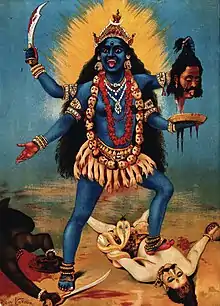Shachi
Shachi (Sanskrit: शची, IAST: Śacī) also known as Indrani (queen of Indra), Aindrila, Mahendri, Pulomaja and Poulomi is the goddess of beauty in Hinduism (specifically, early Vedic accounts), being a source of jealousy because there was no one who did not long for her, and a daughter of Puloman, an Asura who was killed by Indrani's future husband, Indra. She is one of the seven Matrikas (mother goddesses). She is described as beautiful and having the most beautiful eyes. She is associated with lions and elephants. With Indra, she is the mother of Jayanta, Jayanti, and Devasena. In Hindu epics, she is also described as "The Endless Beauty".[1]
| Shachi | |
|---|---|
Queen of Devas Goddess of Beauty, Jealousy and Rage. | |
 Statue of Sachi, also referred as Indrani. | |
| Affiliation | Devi Matrikas Daughter of Asura |
| Mount | Airavata |
| Personal information | |
| Parents | Puloman (father) |
| Consort | Indra |
| Children | Jayanta, Jayanti, Devasena |
Texts
Sachi, despite being an insignificant deity in Vedic literature, has a significance in developing the idea of Shakti which denotes power, the feminine personified might. She gave origin to the concept that a female consort, whether she is Parvati or Kali, is the most important Shakti of all, thus becoming the role model for all the goddesses in later periods (the Purana has several mentions of this concept).[2]
In the Rig Veda she is described to be very beautiful; one of the hymns in Rig Veda pictures her as jealous of rivals. In the same hymn Shachi also asks the god to rid her of rivals. According to the Rig Veda, Shachi is considered a most fortunate female for Indra granted her immortality. It is said that he chose her over all of the other goddesses because of Her magnetic attractions.[3]
It is said that unlike other goddesses, she possess an independent character of her own. Like many goddess wives who are known by their husband's name like Rudrani, Varuni (wife of Varuna), or Saranya (wife of Sun), Shachi too is called "Indrani" and "Aindri". Also, Indra is known after his wife's name as well; hence he is often referred as Shachipati (husband of Shachi; "pati" is Hindi word for "husband"), Shachindra (Schachi's Indra) or Shachivat (Vat 'वत्': A suffix used at the end of words to indicate equality ). As Indra being king of gods - Devarāja, Indrani is queen of gods - Devarāṇī.
Shachi is derived from the verb shak or shach—in Vedas, it is said that shakti/Shachi is something a male god possesses, not female, as the goddess itself is shakti.
In the earlier Vedic accounts, Shachi was depicted as a female shadow of Indra. She was, for a short while, considered to be an evil spirit. She was said to be the daughter of a demon; hence she is sometimes referred to as the Goddess of wrath. Then, in later Hindu interpretations, she began personifying jealousy and evil intent, but after a few years, she became an important and highly worshiped Astral Spirit and is worshiped in South India until this day. Shachihi is rarely worshipped as an independent deity and is usually part of the Saptamatris.[4]
She is a goddess who, even though from a father of demonish origin, is pure, the most beautiful, kind and the one who was a wonder to many eyes; a source of jealousy for long because there was no-one who did not long for her.
Sachi plays a role in the legend of Parijat, where she had a scuffle with Krishna's wife, Satyabhama.[5]
As a Matrika
Goddess Shachi or Indrani is one of the Sapta Matrikas—the seven divine mothers or Saptamatris in Hindu religion. It is said that she has similar characteristics to Indra and the same Vahana or vehicle, a white elephant. A puja dedicated to Goddess Aindrani is performed during the Ashada Navratri.[6]
Jain tradition

In Jain tradition, when a Tirthankara is born, Indra descends with his consort, Shachi, riding their mount, the great elephant Airavata, to celebrate the event.[7]
Buddhist tradition
In the Pāli Canon, she is knows as Sujā, the wife of Śakra. In contrast with the story within Hinduism, while Śakra still defeats her father Vemacitrin, he never kills him and in fact is long-suffering in his failed attempts to try to reform him. Sujā went through a long process and was reborn over many lifetimes to purify herself and become Śakra's wife. She is strongly associated with his protection of the Buddhas and Buddhist practitioners.
In Popular Culture
In the socio-mythological TV series Santoshi Maa, it portrays about the enmity between the Goddess of Jealousy Poulomi Maa and the Goddess of Satisfaction, peace and contentment Santoshi Maa.
Reference
- User, Super. "Shachi". Eastern Spirituality. Retrieved 7 September 2020.
- David Kinsley (1988). Hindu Goddesses: Visions of the Divine Feminine in the Hindu Religious Tradition. University of California Press. pp. 17–18. ISBN 978-0-520-90883-3.
- "Indrani Devi". Goddess Vidya. Retrieved 7 September 2020.
- "Shachi (Indrāṇī)". Jyotiṣmatī. 6 February 2017. Retrieved 7 September 2020.
- https://archive.org/details/puranicencyclopa00maniuoft/page/660/mode/2up
- Leeming, David; Fee, Christopher (15 March 2016). The Goddess: Myths of the Great Mother. Reaktion Books. ISBN 978-1-78023-538-7.
- Goswamy 2014, p. 245.
Further reading
- Goswamy, B. N. (2014). The Spirit of Indian Painting: Close Encounters with 100 Great Works 1100–1900. Penguin Books. ISBN 978-0-670-08657-3.
- Kinsley, David (1998) [1987]. Hindu Goddesses: Vision of the Divine Feminine in the Hindu Religious Traditions. Delhi: Motilal Banarsidass Publishers. ISBN 81-208-0379-5. OCLC 750640724.
External links
| Wikimedia Commons has media related to Indrani. |

